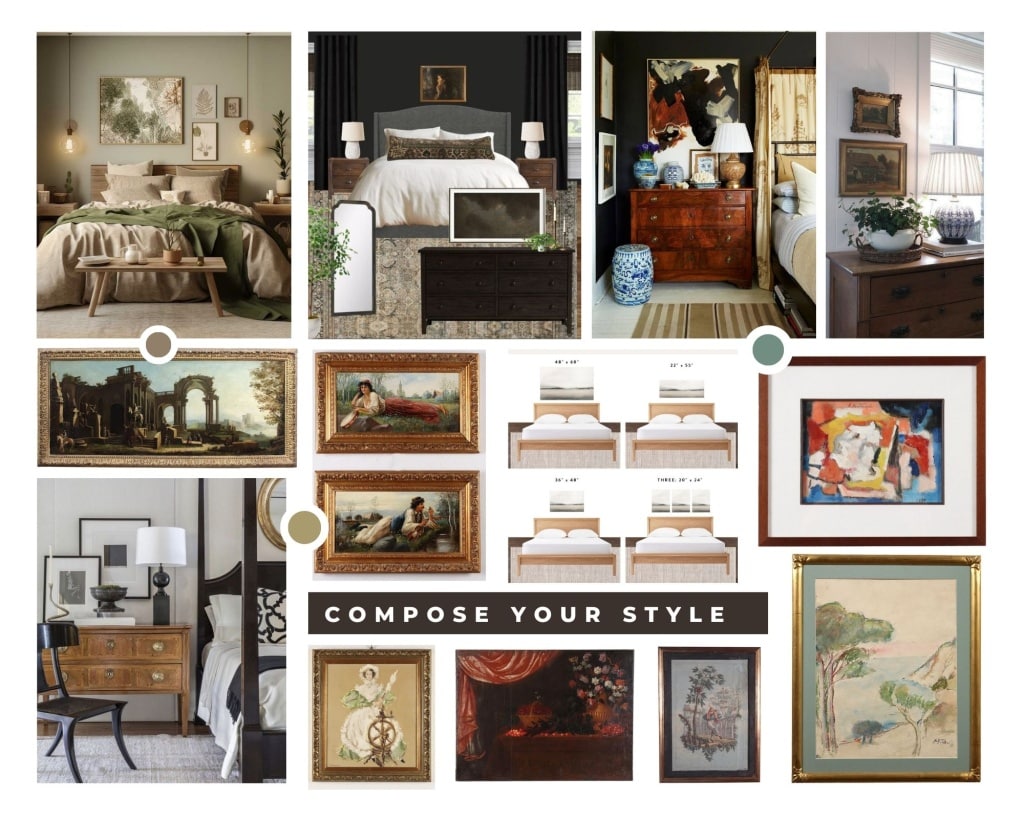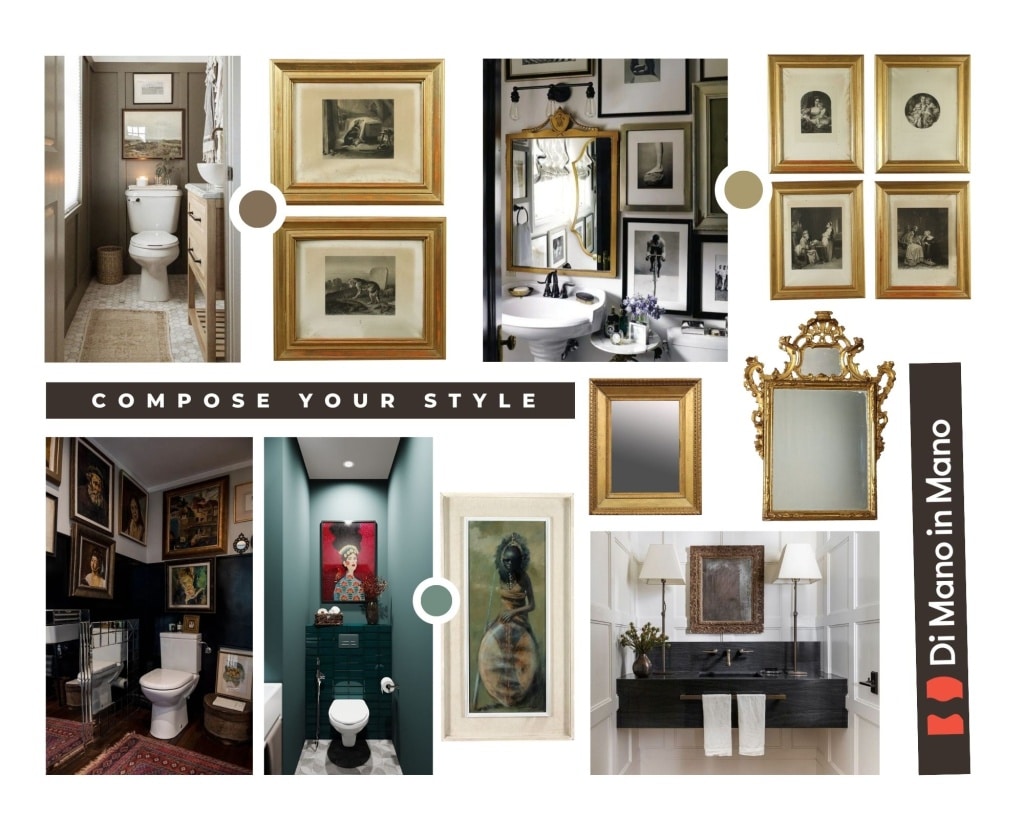
DECORATING WALLS WITH ARTWORK
In this article, I will explain how to hang artwork in an appropriate and original way. Creating a wall gallery means personalizing the home with the tastes and personality of the owner.
To completely transform a room, consider a few details: the color of the walls and the appropriate decorations. No more empty, tone-less walls.
The color palette sets the tone for your spaces and influences the overall mood. Choose a color combination that resonates with your personal style and complements the existing elements of your home.
Consider using a neutral base and infusing touches of color through accent pieces such as artwork or rugs. Softer pastel colors create a serene and relaxing atmosphere, while bold, vibrant shades add energy.
The walls of your home are meant to be filled and decorated. Anything can adorn a wall: an abstract painting, a rural or coastal landscape, a human figure, or anything that helps you “dress” the walls of your home.
It’s important to find balance and avoid overcrowding the space with too many patterns. Choose a dominant motif and complement it with more subtle designs. Showcase artwork and personal touches: bring personality to your spaces by displaying art and photographs.

Let’s move on to decorations, understood as the display of artwork and its arrangement.
First, you need to define the area that will be adorned with paintings, prints, photos, and more. In some cases, where possible, there may be shelves or low furniture where the artwork can be placed.
You also need to consider the layout of the area: horizontal or vertical, and decide what the gallery will consist of. The artwork can include posters, maps, photos, and travel souvenirs. If placed on shelves, you can add vases, sculptures, books, and other decorative objects.
Whether it’s a modern or classic painting, the artwork should always be placed in balance with the overall décor. For example, you can create a corner that becomes the center of the room, where the right painting or sculptural work draws all attention to itself.

In the photographed examples, you can see some arrangements that enhance small corners of the home.
In our “online exhibition” Antiques, Design, and Vintage Store Cambiago – Di Mano in Mano, many pieces will satisfy all your tastes.
For example, a classic painting, a work by Raoul Viviani, is paired with a 1960s sideboard, or a 19th-century marble bust placed to decorate a console.
Creating the right composition and understanding how to arrange artwork on the walls is not an easy task.
You need to pay attention to the height of the artwork from the floor: they should not be placed too low or too high. The ideal height is at eye level.
So, if the artwork is hung aligning to the bottom, it should be 120 cm from the floor. If it’s next to or in front of a sofa, it should be 100 cm from the floor.
Living & Kitchen

In the photos above, I tried to recreate situations such as the corner of an entrance or part of a corridor enhanced by classic consoles: in our exhibition, you will find countless versions of consoles by clicking the link or visiting our Milan location.
You will also find a wide display of paintings or collections to pair and enhance these corners, and to decorate the walls near the sofa.
If you have a kitchen separate from the living room, usually the wall dedicated to the table and chairs is the one that remains free of upper cabinets and on which paintings can be hung. A print centered over the table is perfect, or two as long as they do not exceed the size of the table’s side. The bottom edge should be 1 meter high. Alternatively, on a wall that remains free if your kitchen is open to the living room.
On the wall above the sofa, a classic position, a large painting, canvas, or print can look great, centered relative to the sofa. Alternatively, compositions of multiple framed pieces can be used.
Always observe the rule of the height from the ground of 110 / 120 cm. It’s different if the frames are resting on a shelf.

In the living room, which is definitely the most lived-in area of the house, decorating with paintings and their proper placement may seem a bit simpler. It is the place where you generally have the opportunity to display a larger number of pieces. So, where can we hang paintings in the living room? Above a storage unit as a first suggestion.
On the wall above the sofa, a classic position, a large painting, canvas, or print can look great, centered relative to the sofa. Alternatively, compositions of multiple framed pieces can be used. Always observe the rule of the height from the ground of 110 – 120 cm. It’s different if the frames are resting on a shelf.

Take care with styles and colors. A painting should match the overall atmosphere of a home. If the home is classic, it will require paintings that do not stray too far from that style, just as an ultra-modern environment will be enhanced by a minimal or contemporary painting, such as those with abstract and particularly essential images.

If you have a kitchen separate from the living room, usually the wall dedicated to the table and chairs is the one that remains free of upper cabinets and on which paintings can be hung. A print centered over the table is perfect, or two as long as they do not exceed the size of the table’s side. The bottom edge should be 1 meter high.
Or on a wall that remains free if you have an open kitchen to the living room.
If you have shelves or free countertop areas, they can become the base to place not only paintings but also silver objects, trays, and decorative plates.
In this case, we also have a great collection of collectible items and accessories from every era and style.

Bed-room
The wall behind the bed is the traditional spot for hanging paintings. Keep in mind that they should be hung about 90-100 cm from the floor. If you opt for a large one, it is better to center it above the headboard. If you choose an original composition with different-sized frames, be careful not to exceed the size of the bed.
In addition to the wall above the bed, paintings can also be hung above a dresser, chest of drawers, or any storage furniture in the room.
In the selected images, we feature classic 19th-century or 20th-century paintings.
Whether they are landscapes, religious scenes, or portraits, make sure to create contrast with the color of the wall they are placed on.
As always, we include in our moodboard works from our exhibition.

In the selected images, we feature classic 19th-century or 20th-century paintings, but also modern and contemporary works visible in our exhibitions in Milan and Cambiago.
Whether they are landscapes, religious scenes, or portraits, make sure to create contrast with the color of the wall they are placed on.

Bathroom
It is often thought that it is difficult to hang paintings in the bathroom.
However, it is possible even in this room. If the tiles are 120 cm high, paintings can easily be placed on the exposed wall areas.
If the walls are not tiled, creating spaces becomes easier, as we can create the gallery according to the schemes we have already outlined.
Landscapes or, why not, exotic paintings are preferred, rather than prints or photographs. Special attention will be given to the mirror, whose frame should be prominently displayed. In the examples provided, the mirrors found in our exhibition are mostly classic, but can be paired with modern bathroom compositions as storage solutions.







